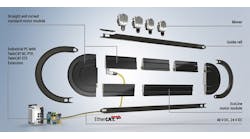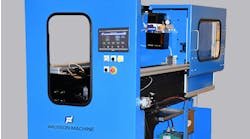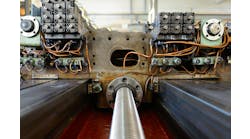When discussing the physics of linear motion, rotary and oscillating motion often surface, as well. Linear motion is more than just displacement; it has a start and a stop point, and compressed air and rotary motion often drive the physics of the move and the resulting cycle time.
Fortunately, calculus is not needed to calculate linear motion as it is simplified by assuming a constant acceleration. The equations for linear motion and the related variables including constant acceleration, displacement, velocity and time are easily accessible.
Linear-motion automation components, such as pneumatic actuators and motor-driven actuators, all operate within the defined physics equations. All motion starts and stops, but some are easy to create multiples of such. Most provide the ability to adjust positions of the start and stop points, but accuracy and repeatability vary, and some are programmable.
Linear motion, moving the part or tooling, is initiated and stopped in many ways. Compressed air and rotary motion are two of the most common methods used on automated equipment, and each method controls the motion in different ways.
The compressed air controlled through air-preparation units, solenoids, tubes and flow controls actuates cylinders and pneumatic actuators. This pneumatic actuated linear motion usually only has two positions, such as advanced/ returned, extended/ retracted, raised/ lowered or open/ closed. The advanced and returned displacement—the start and stop position—can be adjusted, and the speed of the move can be varied.
Simple pneumatic linear motion literally runs into hard stops at each end of travel; the travel is often fixed. These hard stops can be built internally to the cylinder or actuator or mounted externally either to the device itself or surrounding support structure. In any case, it’s good practice to decelerate and even stop the cylinder piston before impacting the end cap. The stops are more like cushions as metal-to-metal stops are loud and abrupt. As the speed of the motion increases, external shock absorbers or soft-bump stops are often used to control the stopping of the actuator at the end of travel.
System air pressure, solenoid valve and hose size, and the air volume through a flow control all combine to determine pneumatic-actuator velocity and acceleration. These actuators often accelerate the whole motion before hitting the hard stop. Obviously, machine cycle time drives the actuator speed requirements, but the cylinder speed should only be set as fast as needed. If the cylinder extends and waits or the cycle time is faster than needed, adjusting the flow control to reduce the speed can greatly soften the abrupt stops at the end of travel.
The repeatability of the hard-stop positioning is well under 0.01 inch, but adjusting it to an accurate position can be difficult. Moving the advanced or retracted position of an end-of-travel stop by loosening a nut, turning a bolt and retightening the nut may require several tries to get within a few thousandths of an inch of the desired position.
Better control of the linear motion speed, acceleration and starting and stopping positions is possible by adding rotary motion to an appropriate linear motion actuator instead of compressed air. Improved precision and gentler operation can be had using rotary motion via a variable-frequency dive (VFD) and motor, stepper motor and servo motor. And there are other differences.
To start, these motor-driven linear actuators are not supposed to run into hard stops. That would be a crash condition, and certainly not a gentle-stop method. It may even damage the actuator or the carriage and bearings in the device. The controlling drives and automation controllers are programmed to move the carriage between the hard stops in this case, without contacting them.
Another difference is that end-of-travel switches on motor-driven linear actuators are not meant to be actuated during normal operation such as advanced and returned sensors are on pneumatic actuators. Activating end-of-travel switches on a motor-driven actuator will usually cause the motor drive to perform an immediate stop before the physical end of travel is reached.
In more precise applications, such as moving between two or more programmable points, a home switch is part of the precise and gentle stopping performance of these motor-driven linear actuators. Open-loop control, such as step and direction signals to a stepper motor drive or closed-loop control such as encoder feedback to the servo motor drive, allow programming of target positions that are then reached via a discrete signal, analog voltage or controller instruction block.
The linear motion is stopped differently in pneumatic actuators and motor-driven actuators. Both have methods to ensure gentle stops. Cushions and shocks used in pneumatic applications quickly and smoothly stop the load. With motor-driven actuators, the controller and related program provide smooth stopping at many locations, precisely. All linear motion eventually comes to a stop.






